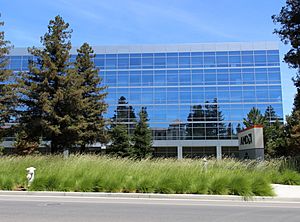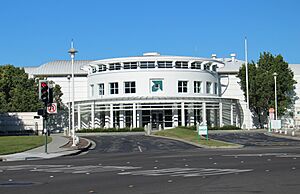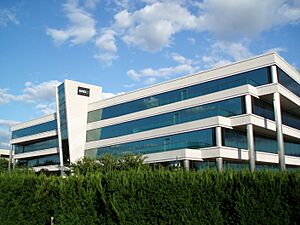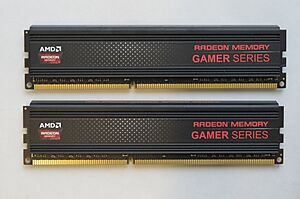AMD facts for kids
 |
|

Headquarters in Santa Clara, California, in 2020
|
|
|
Trade name
|
AMD |
|---|---|
| Public | |
| Traded as | |
| Industry |
|
| Founded | May 1, 1969 |
| Founder | Team led by Jerry Sanders |
| Headquarters |
,
United States
37°22′56″N 121°58′15″W / 37.38222°N 121.97083°W |
|
Area served
|
Worldwide |
|
Key people
|
|
| Products |
|
| Brands | |
| Revenue | |
|
Operating income
|
|
| Total assets | |
| Total equity | |
|
Number of employees
|
c. 28,000 (2024) |
Advanced Micro Devices, Inc. (often called AMD) is a big American technology company. It is based in Santa Clara, California, and also has major offices in Austin, Texas. AMD designs and develops important computer parts.
These parts include central processing units (CPUs), which are like the "brains" of a computer. They also make graphics processing units (GPUs), which handle all the visuals you see on a screen. AMD also creates special chips called field-programmable gate arrays (FPGAs) and system-on-chip (SoC) solutions.
AMD's products are used in many areas. This includes gaming, large data centers, artificial intelligence (AI), and special embedded systems. You can find AMD processors in personal computers, laptops, servers, and video game consoles.
The company started by making its own chips. However, since 2009, it has mostly focused on designing chips and lets other companies manufacture them. In 2022, AMD bought Xilinx, which added FPGA products to its lineup.
AMD was founded in 1969 by Jerry Sanders and other tech experts. Early on, they made memory chips. In 1975, AMD started making microprocessors, competing with Intel. In the early 2000s, AMD grew a lot with its Athlon and Opteron processors.
Later, AMD faced challenges keeping up with Intel. But in the late 2010s, AMD became very competitive again. This was thanks to its Ryzen processors, which offered great performance at good prices. By 2022, AMD's value in the market even passed Intel's for the first time.
Contents
AMD's Journey: A Look at Its History

How AMD Started
Advanced Micro Devices was officially started on May 1, 1969. Jerry Sanders and seven friends from another company, Fairchild Semiconductor, founded it. Sanders, an electrical engineer, wanted to create a new semiconductor company. This was similar to what Robert Noyce and Gordon Moore did when they started Intel in 1968.
In September 1969, AMD moved to Sunnyvale, California. To get customers quickly, AMD first made copies of microchips designed by other companies like Fairchild. AMD focused on making high-quality chips. This was important because unreliable chips were a big problem back then.
AMD's first product, the Am9300, was made in November 1969. It was a 4-bit shift register. In 1970, AMD made its first own product, the Am2501 logic counter, which was very successful. By 1971, AMD's yearly sales reached $4.6 million.
AMD became a public company in September 1972. By 1975, AMD was making 212 different products. About 49 of these were their own designs.
Entering the Microprocessor Market
Intel created the first microprocessor in 1971. In 1975, AMD entered this market with the Am9080. This chip was a copy of Intel's 8080. AMD also released the Am2900 microprocessor family.
In 1976, AMD and Intel made an agreement. This allowed AMD to use Intel's special code (microcode) in its chips.
In 1977, AMD partnered with Siemens, a German company. Siemens bought 20% of AMD's stock, giving AMD more money to grow. They also started a joint company called Advanced Micro Computers (AMC). However, their ideas for AMC were different, so AMD bought out Siemens' share in 1979. AMD closed AMC in 1981 to focus on making Intel x86 microprocessors.
By 1978, AMD's sales reached over $100 million. In 1979, AMD started trading on the New York Stock Exchange. They also began building a new chip factory in Austin, Texas.
Working with Intel
In 1981, IBM wanted to use Intel's x86 processors for its new PC. But IBM required that Intel also have another company make the chips. So, Intel and AMD signed a 10-year agreement in 1982. This deal allowed each company to make and sell products designed by the other.
Because of this agreement, AMD started making Intel's 8086, 8088, and 80186 processors. By 1984, AMD made its own version of Intel's 80286 processor, called the Am286. These chips were for the fast-growing market of IBM PCs.
AMD kept investing a lot in research. In 1984, they created the world's first 512K EPROM (a type of memory chip). AMD was even listed as one of "The 100 Best Companies to Work for in America" in 1984.
In the mid-1980s, the microchip market faced a tough time. AMD responded by creating new chips quickly. They also pushed the U.S. government to stop unfair pricing from other countries. During this time, AMD stopped making DRAM memory chips.
In 1991, AMD introduced its own chip, the Am386, which was compatible with Intel's 386. This meant AMD started directly competing with Intel.
In 1996, AMD bought NexGen for $857 million. NexGen was working on a new microprocessor, which became the AMD K6.
AMD also had a successful business making flash memory. In 2003, AMD spun off this business into a new company called Spansion. This helped AMD focus more on microprocessors.
Big Changes: 2006 to Today
On July 24, 2006, AMD announced it would buy ATI Technologies, a Canadian company known for 3D graphics cards. This deal cost AMD about $5.4 billion and was completed in October 2006. Later, in 2010, AMD decided to use the AMD brand name for its graphics chips instead of ATI.
In October 2008, AMD decided to separate its manufacturing factories into a new company called GlobalFoundries. This was a joint venture with an investment company from Abu Dhabi. This move helped AMD get more money and focus only on designing chips.
In 2011, Rory Read became AMD's new CEO. The company faced some challenges and had to reduce its staff. However, AMD chips were chosen for the PlayStation 4 and Xbox One gaming consoles. Many believe this helped save AMD from financial trouble.
In October 2014, Lisa Su became the new CEO of AMD. She had been the chief operating officer before this. Under her leadership, AMD reorganized its business into two main groups: Computing and Graphics, and Enterprise, Embedded, and Semi-Custom.
In August 2016, AMD moved its headquarters from Sunnyvale to a new building in Santa Clara. This new location is very close to Intel's headquarters.
In October 2020, AMD announced it was buying Xilinx, a leader in special chips called FPGAs. This big deal, worth about $50 billion, was completed in February 2022.
AMD continued to grow its AI capabilities. In October 2023, AMD bought Nod.ai, a company that makes open-source AI software. In July 2024, AMD acquired Silo AI, a Finnish AI startup, for $665 million. In August 2024, AMD also signed a deal to buy ZT Systems for $4.9 billion. ZT Systems creates custom computer systems for AI tasks.
By July 2025, AMD had significantly increased its share in the server CPU market. While Intel still leads, AMD has reached 36.5% of the market, showing strong growth.
How AMD Grew Through Acquisitions
AMD has bought several companies over the years to expand its technology and products.
- January 1996: Acquired NexGen to develop the AMD K6 processor.
- July 2006: Acquired ATI Technologies for its graphics and 3D software, leading to the Radeon GPUs.
- February 2012: Acquired SeaMicro for data center platforms.
- October 2020: Acquired Xilinx for custom chips like FPGAs.
- April 2022: Acquired Pensando for data center and cloud solutions.
- October 2023: Acquired Nod.ai for open-source AI software.
- July 2024: Acquired Silo AI for AI software.
- August 2024: Acquired ZT Systems for data center hardware used in AI.
AMD's Products
CPUs and APUs
- AMD microprocessors
Early Chips for IBM PCs
In 1982, AMD signed a deal with Intel to make Intel's 8086 and 8088 processors. IBM wanted to use these chips in its first personal computer. But IBM required at least two companies to make the chips. AMD later made the Am286 under the same agreement.
However, Intel stopped sharing technical details for its newer chips. This led to a long legal fight between AMD and Intel. AMD eventually won in 1992, allowing them to use Intel's microcode for some older chips.
In 1991, AMD released its own version of the Intel 386 processor, called the Am386. It sold a million units by October of that year. In 1993, AMD introduced the Am486 family, which became popular with computer makers.
K5, K6, Athlon, and More
AMD's first self-designed x86 processor was the K5, launched in 1996. The "K" stood for Kryptonite, a fictional substance that could harm Superman. This was a playful jab at Intel, which was seen as the "Superman" of the market.
In 1997, AMD released the K6 processor. It was based on a design from NexGen, a company AMD bought. The K6 was very competitive with Intel's chips at the time.
The K7 was AMD's seventh-generation x86 processor, launched as the Athlon on June 23, 1999. Unlike earlier AMD chips, it needed different motherboards than Intel's. The Duron and Sempron were cheaper versions of the Athlon.
The Athlon XP was released in October 2001, with an updated version in 2003.
Athlon 64, Opteron, and Phenom
The K8 architecture was a big update to the K7. It added 64-bit computing to x86 chips, called x86-64 or AMD64. It also included a memory controller right on the chip. This technology first appeared in the Opteron server processor in 2003. Soon after, it was used in desktop PCs as the Athlon 64.
In 2005, AMD released the first dual-core Opteron. A month later, they released the Athlon 64 X2, their first dual-core desktop processor.
In September 2007, AMD released the K10 processors, including the Phenom for desktops. K10 chips came with two, three, or four cores on a single chip. However, these chips were not as power-efficient as Intel's chips at the time.
In 2009, AMD released the Phenom II line, which improved on the original Phenom. These chips were more competitive in terms of performance and price. In 2010, AMD released the Phenom II Hexa-core (6-core) processor. It included "turbo core" technology, which could speed up some cores when needed.
Fusion Becomes AMD APU
After buying ATI Technologies in 2006, AMD started a project called Fusion. The idea was to combine a CPU and a GPU onto one chip. This new type of chip was later renamed the AMD APU (Accelerated Processing Unit).
The first APU for laptops was called Llano. It combined a CPU, GPU, and other functions on one chip. AMD APUs are now common in laptops running Windows. They come in different series like E1, E2, and A-series (A4, A6, A8, A10), offering various levels of performance.
New Chip Designs
Powerful Bulldozer Cores
Bulldozer was a new chip design from AMD for servers and desktops, released in 2011. AMD hoped it would make their chips much faster and more efficient. However, early tests showed that Bulldozer chips were sometimes slower than older AMD designs.
Later versions, like Piledriver (2012), Steamroller (2013), and Excavator (2015), improved on the Bulldozer design. They focused on increasing speed and power efficiency.
Energy-Efficient Cat Cores
AMD also developed smaller, more energy-efficient chips called Bobcat (2011). These were designed for devices that needed less power, like small computers.
The Jaguar design (2013) followed Bobcat. Jaguar chips were used in the PlayStation 4, Xbox One, and their updated versions. The Puma design (2014) was another update in this series.
ARM-Based Designs
In 2012, AMD announced it was working on chips based on the ARM design. These were for servers and custom products. The first ARM server chip, the Opteron A1100, was released in 2016.
AMD also planned a custom ARM core called K12 for 2016. However, AMD later decided to focus more on its x86-based Zen chips.
Zen-Based CPUs and APUs
Zen is a major new chip design for AMD's Ryzen CPUs and APUs. It was introduced in 2017. A team led by Jim Keller designed it from scratch.
A key goal for Zen was to increase the number of instructions a chip could handle per clock cycle by at least 40%. AMD actually achieved a 52% increase! Zen chips are also more energy-efficient.
Zen was the first architecture to use a single socket (Socket AM4) for both CPUs and APUs. It also introduced simultaneous multithreading (SMT), which helps chips handle more tasks at once. Zen also supports faster DDR4 memory.
AMD released the high-end Ryzen 7 "Summit Ridge" CPUs in March 2017. Mid-range Ryzen 5 and entry-level Ryzen 3 followed. AMD also released Epyc server processors based on Zen. In October 2017, Zen-based APUs with Vega graphics were released for laptops.
AMD continued to update Zen with Zen+ (2018), Zen 2 (2019), and Zen 3 (2020). By 2019, AMD's Ryzen processors were reportedly selling more than Intel's desktop processors. In August 2022, AMD announced its first CPUs based on the new Zen 4 architecture.
The Steam Deck, PlayStation 5, and Xbox Series X and Series S all use custom chips based on the Zen 2 architecture. In March 2025, AMD announced Instella, an open-source large language model.
Graphics Products and GPUs
- AMD graphics processing units
Radeon Graphics at AMD
In 2007, AMD's ATI division released the TeraScale microarchitecture. This new design used flexible, programmable shaders instead of older fixed hardware. This technology was first used in the GPU for the Xbox 360 and later in Radeon HD 2000 graphics cards.
In 2009, AMD combined its CPU and GPU divisions. This was to support its new APUs, which mix graphics and general processing. In 2011, AMD released Graphics Core Next (GCN), a new microarchitecture. GCN was designed to be good at both graphics and general computing, especially for AMD's APUs.
Radeon Technologies Group
In September 2015, AMD created a separate group called the Radeon Technologies Group (RTG). This group focuses only on graphics technology. RTG then created and released the Polaris (2016) and Vega (2017) microarchitectures. The Vega design included big updates to improve performance.
In January 2020, AMD announced its second-generation RDNA graphics architecture. The goal was to compete with Nvidia's powerful RTX graphics cards. In October 2020, AMD launched its new RX 6000 series GPUs. These were AMD's first high-end cards based on RDNA2 and could handle ray-tracing, a new lighting technology in games.
Custom Chips for Game Consoles
In 2012, AMD started offering custom chip designs. This meant customers could work with AMD to create a special chip using AMD's technology. AMD was unique because it could offer both x86 CPU and graphics technology.
These custom designs were chosen for the APUs in the PlayStation 4 and Xbox One game consoles. They were also used in later versions like the PlayStation 4 Pro, Xbox One S, Xbox One X, Xbox Series X/S, and PlayStation 5. These custom chips became a big part of AMD's income by 2016.
In November 2017, AMD and Intel announced a surprising partnership. Intel would sell a product that combined an Intel Core CPU, a custom AMD Radeon GPU, and special HBM2 memory in one package.
Other Hardware Products
AMD Motherboard Chipsets
Before 2003, AMD designed chipsets (which help different parts of a computer talk to each other) for its K6 and K7 processors. But with the Athlon 64 processors in 2003, AMD stopped designing its own desktop chipsets. Instead, it allowed other companies like ATI and VIA to make chipsets for its processors.
After AMD bought ATI Technologies in 2006, it gained ATI's chipset design team. AMD then started renaming these chipsets under the AMD brand. In 2007, AMD released the 690G chipset, which was the first to include an HDMI port on motherboards.
When AMD's APUs came out in 2011, many traditional chipset features moved directly onto the APU chip. The remaining chipset was called the Fusion Controller Hub (FCH).
In 2017, AMD released new chipsets for its Ryzen products. These AM4 chipsets were designed with ASMedia and mainly added more connections like PCI Express, USB, and SATA.
Embedded Products
AMD also makes chips for embedded systems. These are computers built into other devices, like casino slot machines, kiosks, or industrial machines.
In the early 1990s, AMD started making AMD Élan chips, which combined a CPU with other computer parts on one chip. These were used in devices like the Nokia 9000 Communicator.
In 2003, AMD bought the Geode business. Geode processors were used in many embedded systems and even in the OLPC XO-1 computer, an inexpensive laptop for children in developing countries.
In 2011, AMD announced the AMD Embedded G-Series APU, the first APU for embedded uses. These have been updated several times since.
AMD also makes graphics processors for embedded systems. These are used in everything from casinos to healthcare equipment.
Current Product Lines
CPU and APU Products
- Athlon – Entry-level CPUs and APUs.
- A-series – Consumer desktop and laptop APUs.
- Ryzen – Main brand for consumer CPUs and APUs.
- Ryzen Threadripper – High-end CPUs for professionals and enthusiasts.
- Epyc – CPUs designed for servers.
Graphics Products
- Radeon – Brand for consumer graphics cards.
- Mobility Radeon – Power-optimized versions for laptops.
- Radeon Pro – Graphics cards for professional workstations.
- Radeon Instinct – Products for machine learning and high-performance computing in servers.
Radeon-Branded Products
RAM
In 2011, AMD started selling Radeon-branded DDR3 SDRAM memory. This memory was made by other companies but sold by AMD to support its APUs. They later released faster gaming memory and DDR4 SDRAM memory.
Solid-State Drives
In 2014, AMD announced it would sell Radeon-branded solid-state drives (SSDs). These fast storage devices were made by OCZ.
AMD Technologies
CPU Hardware
- HyperTransport – A fast connection used in AMD's CPU and APU products.
- Infinity Fabric – A newer version of HyperTransport used in AMD's Zen microarchitecture chips.
Graphics Hardware
- AMD Eyefinity – Allows you to connect up to 6 monitors to one graphics card.
- AMD FreeSync – A technology that makes game graphics smoother by syncing the display with the graphics card.
- AMD TrueAudio – Helps speed up audio calculations in games.
- AMD XConnect – Lets you use external graphics card enclosures with laptops.
- AMD CrossFire – A technology that allows you to use multiple graphics cards at the same time for better performance.
- Unified Video Decoder (UVD) – Speeds up video decoding (playing videos).
- Video Coding Engine (VCE) – Speeds up video encoding (creating videos).
Software
AMD has worked to make its software tools more open.
GPU Software
- GPUOpen is AMD's graphics software platform. It includes features like FidelityFX Super Resolution, which makes games look better.
- ROCm (Radeon Open Compute platform) is AMD's software for machine learning and supercomputing.
- AMDgpu is an open-source driver for AMD graphics cards on Linux.
Other Software
- AMD works on heterogeneous computing, which uses both CPUs and GPUs for tasks.
- AMD contributes to open-source projects. For example, they work with the X.Org Foundation to develop drivers for AMD graphics cards.
How AMD Makes Its Chips
AMD used to make its own chips in its factories. However, the cost of building new factories became very high.
In 2008, AMD spun off its chip factories into a new, independent company called GlobalFoundries. This made AMD a fabless company, meaning it designs chips but pays other companies to manufacture them.
AMD has agreements with GlobalFoundries to produce some chips. But AMD also works with other big manufacturers like TSMC and Samsung. This helps AMD reduce risk by not depending on just one factory.
In 2018, AMD started moving more of its CPU and GPU production to TSMC. This happened after GlobalFoundries decided to stop developing its 7 nm process, which is a very advanced way of making chips.
Company Information
Leaders of AMD
- Jerry Sanders (1969–2002): The founder of AMD.
- Hector Ruiz (2002–2008): An electrical engineer.
- Dirk Meyer (2008–2011): A computer engineer.
- Rory Read (2011–2014): Focused on information systems.
- Lisa Su (2014–present): An electrical engineer, the current CEO.
Business Growth
AMD's business has grown a lot over the years. Here's a quick look at its financial trends:
- 2017: Revenue $5.3 billion, 8,900 employees
- 2018: Revenue $6.4 billion, 10,100 employees
- 2019: Revenue $6.7 billion, 11,400 employees
- 2020: Revenue $9.7 billion, 12,600 employees
- 2021: Revenue $16.4 billion, 15,500 employees
- 2022: Revenue $23.6 billion, 25,000 employees
- 2023: Revenue $22.6 billion, 26,000 employees
Partnerships
AMD works with other companies to grow its business and compete with Intel.
- AMD partnered with IBM to develop new manufacturing technologies.
- AMD works closely with computer makers like HP, Dell, Asus, Acer, and Microsoft.
- In 2006, Dell started using AMD's Opteron chips in its servers, ending an exclusive deal with Intel.
- In 2013, AMD announced it would power the chips for all three major next-generation consoles: the Xbox One, Sony PlayStation 4, and Nintendo Wii U. This helped game developers create games more easily across different platforms.
- AMD is a founding member of the HSA Foundation, which aims to make it easier to use both CPUs and GPUs together for computing tasks.
- In 2016, AMD created a joint venture to make x86 server chips for the Chinese market.
- In 2019, AMD partnered with the U.S. Department of Energy and Cray Inc. to develop the Frontier supercomputer. This supercomputer uses AMD Epyc CPUs and Radeon GPUs and is incredibly powerful.
- In 2020, AMD was chosen to power the next-generation consoles from Microsoft and Sony.
- In November 2021, AMD partnered with Meta to make chips for the Metaverse.
- In January 2022, AMD partnered with Samsung to develop a mobile processor called Exynos 2022, which uses AMD's RDNA 2 graphics.
Legal Disputes with Intel
AMD has had a long history of legal disputes with its rival, Intel.
- In 1986, Intel broke an agreement to let AMD make its microchips for IBM. AMD won the case in 1992, and the decision was upheld in 1994.
- In 1990, Intel sued AMD over the use of its microcode. AMD won this case in 1994, allowing them to use Intel's microcode for chips up to the 486 generation.
- In 2005, Japan found Intel guilty of unfair practices. On the same day, AMD filed a big lawsuit against Intel in the U.S. AMD claimed Intel used secret deals and threats to keep AMD chips out of the market.
- In November 2009, Intel agreed to pay AMD $1.25 billion and renew a patent agreement to settle all ongoing legal disputes between them.
Guinness World Record
- On August 31, 2011, AMD set a Guinness World Record for the "Highest frequency of a computer processor." They ran an FX-8150 processor at an amazing 8.429 GHz, cooled with liquid helium.
- Later, in November 2011, an overclocker (someone who pushes computer parts to go faster) used an FX-8150 to set a new record of 8.461 GHz.
- On November 19, 2012, another record was set at 8.794 GHz using an FX-8350.
Helping the Environment
In its 2022 report, AMD stated its goals to be more environmentally friendly. They aim to make their business more sustainable and promote safe workplaces. In 2022, AMD reduced its greenhouse gas emissions by 19% compared to 2020.
Sponsorships

AMD has sponsored Formula 1 racing since 2002. Since 2020, they have sponsored the Mercedes-AMG Petronas team. AMD also sponsored the Scuderia Ferrari Formula 1 team. In February 2020, the Mercedes Formula 1 team announced AMD as a new sponsor.
AMD also sponsors eSports teams. In 2022, AMD began sponsoring Victory Five (V5) for the League of Legends Pro League (LPL). They also sponsored the Chinese Dota Pro Circuit.
In February 2024, AMD was a major sponsor for the World Artificial Intelligence Cannes Festival (WAICF). In June 2024, AMD was a Platinum sponsor for HPE Discover 2024, an event showcasing technology for businesses.
|
See also
 In Spanish: Advanced Micro Devices para niños
In Spanish: Advanced Micro Devices para niños

























